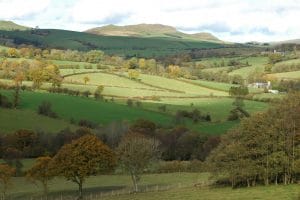Support us from £3/month
We deal with almost 1000 cases a year assisting communities, groups and individuals in protecting their local spaces and paths in all parts of England and Wales. Can you help us by joining as a member?
A Welsh Government minister has approved an application for seven wind-turbines at Llandegley Rocks, near Llandrindod Wells in Powys. The decision overturns the recommendation of an inspector at a public inquiry held in March.

Llandegley Rocks: this view be obliterated by the proposed seven 110-metre-high wind turbines. Photo: Diana Hulton
The Cabinet Secretary for Energy, Planning and Rural Affairs, Lesley Griffiths, has rejected the report of the inspector, planner Hywel Wyn Jones. He concluded, after careful examination of all the evidence, that the turbines would significantly damage the landscape, including views of and from the ‘iconic … distinctive Llandegley Rocks’. They would also have a significantly damaging impact on the setting and views of important prehistoric and mediaeval remains(1). He considered that this damage could not be offset by any mitigating measures offered.
The society was backing the Campaign for the Protection of Rural Wales, New Radnor and Penybont Community Councils, and numerous local objectors.
Says Kate Ashbrook, our general secretary: ‘We are dismayed that the Cabinet Secretary should overrule the carefully-considered recommendations of the inspector. He was decisive in rejecting the plan and robustly confirmed its damaging effect on this beautiful, intimate landscape, its history and culture, and people’s enjoyment of the place. While accepting that the permission was for 25 years he considered that this “is a significant period in the lifetime of individuals who would be denied the opportunity properly to appreciate the assets”.’
The minister decided that the benefits of providing renewable energy outweighed the damage which would be caused.
Kate continues: ‘The objectors will be considering whether there are grounds for judicial review. Meanwhile, it is clear that due consideration has not been given to the fact that four of the turbines are to be built on land to which the public was granted in perpetuity a right of access “for air, exercise and recreation” in 1885 under the Llandegley Rhos and Hendy Bank enclosure awards(2). The award is displayed on tablets in two local churches. We question whether this land can legally be developed.
‘Moreover, the access track to the turbines would be sited on common land. The applicants would have to win consent from the Welsh ministers to deregister the common — and provide suitable land in exchange to which the public does not already enjoy access. We doubt there is any such land in the area that would be eligible. The applicants would also need consent for works on common land.
‘So they have a long way still to go, and the objectors will fight them every inch of the way. This landscape, its beauty and its history are too precious to destroy,’ Kate concludes.
___________________________________
1 The historic remains include the Iron Age Nant Brook Enclosure, the hillforts at Llandegley Rocks and Graig Camp, and the mediaeval Castell Crug Eryr motte and bailey castle.
2 The relevant part of the inclosure award says:
‘And I declare that I do reserve to the Public a privilege at all times of enjoying air exercise and recreation on all parts of the lands to be inclosed which shall be unplanted or uncultivated for arable purposes. And I direct that in the fences of the Allotments gates or stiles shall be placed at convenient intervals at or about the places shown upon the Map hereunto annexed for the purpose of securing access for the Public but in the exercise of the privilege hereby reserved no injury shall be done to the lands or to the herbage or to the fences or to the stock or game or to anything upon such lands. And I declare that in the event of a belt of trees being planted the Public shall not thereby be deprived of the privilege hereinbefore reserved but that access shall be provided by means of paths or openings through the belt of trees to the uncultivated or unplanted land’
